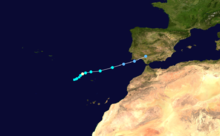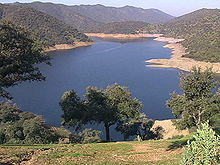
Hurricane Vince
About this schools Wikipedia selection
SOS believes education gives a better chance in life to children in the developing world too. To compare sponsorship charities this is the best sponsorship link.
| Category 1 hurricane ( SSHS) | |
|---|---|
 |
|
| Hurricane Vince on October 9 14:23 UTC | |
| Formed | October 8, 2005 |
| Dissipated | October 11, 2005 |
| Highest winds | 1-minute sustained: 75 mph (120 km/h) |
| Lowest pressure | 988 mbar ( hPa); 29.18 inHg |
| Fatalities | None reported |
| Areas affected | Madeira Islands, Southern Portugal, Southwestern Spain |
| Part of the 2005 Atlantic hurricane season | |
Hurricane Vince was an unusual hurricane that developed in the northeastern Atlantic basin. Forming in October during the 2005 Atlantic hurricane season, it strengthened over waters thought to be too cold for tropical development. Vince was the twentieth named tropical cyclone and twelfth hurricane of the extremely active season.
Vince developed from an extratropical system on October 8, becoming a subtropical storm southeast of the Azores. The National Hurricane Centre (NHC) did not officially name the storm until the next day, shortly before Vince became a hurricane. The storm weakened at sea and made landfall on the Iberian Peninsula as a tropical depression on October 11. Vince was the first tropical system to do so since the 1842 Spain hurricane. It dissipated over Spain, bringing much needed rain to the region, and its remnants passed into the Mediterranean Sea.
Meteorological history
On October 5, an operationally unnamed subtropical storm which had gone unnoticed by the NHC was absorbed by a temperate frontal low, which was moving to the southeast over the Azores. The low pressure system gained a more concentrated circulation and lost its frontal structure after absorbing the subtropical storm. The developing system became a subtropical storm itself early on October 8, 580 miles (930 km) southeast of Lajes in the Azores. However, the NHC decided not to name the system Vince at the time, because the water temperature was too low for normal development for a tropical cyclone. The storm gradually gained the tropical characteristics of symmetry and a warm inner core and became a tropical storm the next day. Its transformation to a tropical system occurred over water cooler than 24 °C (75 °F), much colder than the 26.5 °C (80 °F) usually required for tropical development.
Soon after it became a tropical storm on October 9 near Madeira, with a ragged eye already present, the NHC officially named it Tropical Storm Vince and began to issue advisories. At the time there was some uncertainty as to whether Vince was tropical or subtropical but, in his post-season analysis, forecaster James L. Franklin of the NHC conceded that Vince had formed as a subtropical storm and had evolved into a tropical storm before it was named. The storm's ragged eye quickly solidified and contracted into a "bona fide" eye with a diameter of 15 mi (25 km). This increase in organization was accompanied by strengthening, and Vince reached its peak strength as a hurricane with 75 mph (120 km/h) winds later that day. The NHC forecaster decided that "if it looks like a hurricane, it probably is, despite its environment and unusual location".
Hurricane Vince's impressive organization was very short lived as westerly wind shear began to erode the eye within hours. In response, the storm weakened to a tropical storm shortly thereafter. A broad low-level trough approached the storm from the northwest, pulling the convection northward as the storm's low-level centre accelerated eastward. On October 10, two brief bursts of convection surprised forecasters, but with the sea surface temperature as low as 22 °C (72 °F), the flares were not sustained. Vince continued to weaken as it approached the Iberian Peninsula and became a tropical depression on October 11, shortly before it made landfall near Huelva, Spain. The fast-moving tropical depression quickly dissipated over land. Its remnants moved across southern Spain, dumping rain on the drought-ridden region, and moved into the Mediterranean Sea south of Alicante in the early hours of October 12.
Preparations and impact
The Spanish Centre for Emergency Coordination declared a rain pre-emergency for the province of Castellón in the anticipation that Hurricane Vince would bring rains capable of flooding. The Instituto Nacional de Meteorología (INM) issued a bulletin that warned of a 40% chance of flooding. Four autonomous regions ( Asturias, Cataluña, Castile and León, and Galicia) issued flood warnings, and Canarias issued a wind warning. Spanish fishing fleets off the Andalusian coast returned to port and weathered the storm on their moorings rather than in the open ocean.
Spain's population, which had been battling fires after a record breaking summer drought, welcomed the rains brought by Vince's remnants. In two days the storm brought more rain to the province of A Coruña than had fallen all summer, easing the sinking water levels in provincial reservoirs, but also causing traffic jams and minor floods. In Córdoba province, the A-303, A-306 and OC-293 roads were partially flooded but "passable with caution". Municipal roadworks on la Ronda de Poniente, a major traffic artery connecting the city to nearby highways, were flooded and partially destroyed. The entrance of the University of A Coruña was temporarily blocked by flood waters on October 11, and a nearby roundabout was submerged. These damages were minor, and no fatalities were reported. The highest winds reported on land were 48 mph (77 km/h) at Jerez, Spain, although some ships recorded stronger. Vince was comparable to normal rain events from temperate systems, with only 1 to 2 inches (25 to 50 mm) of rain falling. Through a play on words of a song in the musical My Fair Lady, National Hurricane Centre forecaster James Franklin in the Tropical Cyclone Report for Vince wrote, "the rain in Spain was mainly less than 2 inches, although 3.30 inches (84 mm) fell in the plain at Córdoba."
Records and naming
Although Hurricane Vince developed in an unusual location in the northeastern Atlantic, well away from where tropical cyclones are usually found, it is neither the most northerly-forming nor the most easterly-forming Atlantic tropical storm; these records are held by Alberto of the 1988 season at 41.5° N, and Ginger of the 1967 season at 18.1° W, respectively.
Hurricane Vince developed into a hurricane farther east than any known storm, at 18.9° W. The National Hurricane Centre declared that Vince was the first tropical cyclone on record to have made landfall on the Iberian Peninsula. Historical documents, however, suggest that a possibly stronger tropical storm, the 1842 Spain hurricane, struck the Iberian Peninsula on October 29, 1842. Vince's record north was broken by Tropical Storm Grace (2009).
When Subtropical Storm Vince formed on October 8, it was the earliest in the season that the twenty-first tropical or subtropical storm had ever developed, 38 days ahead of the previous record held by Tropical Storm Twenty-one of the 1933 season. Hurricane Vince was also the first named "V" storm in the Atlantic since naming began in 1950. Because the storm did not cause significant damage, the name Vince was not retired by the World Meteorological Organization and was on the list of names for the 2011 season.



